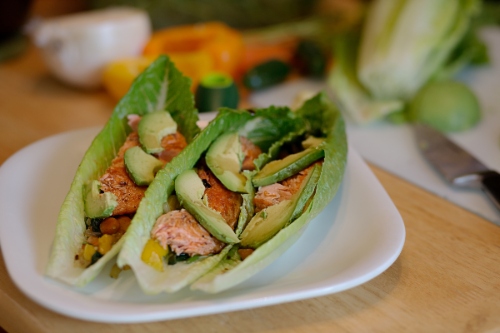Smart Supermarket Tips for a Healthy New Year

With 2020 in everyone’s rearview mirror, many are ready to shed the pandemic blanket, jump off the couch and into a new year filled with unlimited possibilities, including making changes for a healthier life. Living a healthier lifestyle sometimes requires a slight change in how we process information. This is why Wounded Warrior Project® (WWP) offers physical health and wellness programs to support veterans and their family members.
Often the first thought in the new year is on physical fitness. But getting active with a regular workout routine shouldn’t be the only focus of a healthy lifestyle; a healthy diet is a part, too. Navigating the supermarket effectively is one of the keys to ensuring you’re eating quality nutrients.
Grocery stores are organized to increase sales — not health and wellness — but there are ways to outsmart the system. While moving through the aisles, you will notice easily accessible placement of canned and processed items. These are more convenient to pick up, but not the healthier items. Take the time to read food labels, and remember “healthy” labels don’t always prove true. Some nutrition bars have as many calories as a candy bar, so always check the ingredients and nutrition facts.
This is why Wounded Warrior Project® (WWP) has broken down what to look for through grocery store aisles on your journey to a healthier you!
Produce
You have found your new happy place — there’s very little to avoid here. Remember to look for fruits and vegetables that are fresh and in season for maximum flavor and value. If something is out of season, it will be more expensive due to additional transportation and storage costs.
Bakery
Fresh-baked bread can be deceiving because it doesn’t always have nutrition facts on the label. Don’t buy it if it doesn’t have a label – you can ask the bakers to share the recipe and ingredients. Look for ingredients that have whole wheat. The first ingredient should be whole grain, and bread should have at least three grams of fiber for each serving.
Deli and Meats
The best choices here are lean meat and fish. Avoid meats with visual fat around the edges and throughout (marbling). Be careful of deli meats, which can be very high in sodium. If you want to go an extra step, try purchasing meat from local farmers’ markets and fish from local seafood markets.
Canned Goods
Canned goods can also contain a lot of sodium because salt is used as a preservative. Fresh and frozen foods are your friends — but if they are not an option, be on the lookout for canned goods labeled “sodium-free.”
Snacks
We understand; everyone has urges to snack. If you look hard enough, you may find a few diamonds in the rough. Just try to avoid items high in trans fat. Find great alternatives in the gluten-free area.
Pasta and Rice
Long grain and brown rice are good, just like whole grain wheat pasta. And now there are more gluten-free pasta options. Remember to get your three grams of fiber per serving.
Condiments
This aisle has some unknown traps since many items can be high in salt and sugar. For example, ketchup and barbecue sauce are surprisingly loaded with sugar. Also, salad dressings, olives, pickles, and marinades often have a lot of sodium.
Coffee, Tea, and Cereal
Coffee and tea are great substitutes for soda. When it comes to cereals, lean toward whole grain and high-fiber options. According to the American Heart Association, including these in a diet can provide important health benefits, like improved blood cholesterol levels and lowered risk of heart disease and stroke.
Sodas and Other Beverages
Most sodas are very high in sugar and have no nutritional value. Even no-calorie versions have sugar substitutes. Be careful of beverages with added vitamins, minerals, and herbs — they usually aren’t healthier choices. Water is a great selection that has many fun options to mix it up. You can add lemon, cucumber, mint, and all kinds of wonderful fresh herbs.
Chips and Bread
Chips have saturated fats and salt — two things to avoid when choosing healthy items. Try whole-grain bread, and avoid packed snacks high in sugar, salt, and fat.
Dairy
There are some good low-fat options in this section. Full-fat dairy is very high in calories. Try milk that is 2% or lower, and remember 2% milk still gets a third of its calories from fat. Greek yogurt has much less sugar than other yogurts, and it’s higher in protein. It’s a healthy choice with fresh fruit and is also a great substitute for sour cream.
Frozen Foods
When it comes to fruits and vegetables, the frozen foods aisle is a good place. When it comes to frozen pizzas and pot pies, it’s a bad place. Fruits and vegetables are picked at the peak of their freshness, so they retain a lot of flavor, minerals, and vitamins. Freezing them can keep them “fresh” for a longer period. Frozen meals are very high in sodium and sugar. Stick with the ones that have less than three grams of fat but at least three grams of fiber for each serving.
Registering with WWP for veteran family support programs is a way for veterans to stay on the track of good health through programs that include adaptive sports, nutrition coaching, and recreational activities.
Click here to learn more about healthy living practices available to wounded warriors through WWP’s Physical Health and Wellness Program.
Contact: Vesta M. Anderson – Public Relations, vanderson@woundedwarriorproject.org, 904.570.0771
About Wounded Warrior Project
Since 2003, Wounded Warrior Project® (WWP) has been meeting the growing needs of warriors, their families, and caregivers – helping them achieve their highest ambition. Learn more.